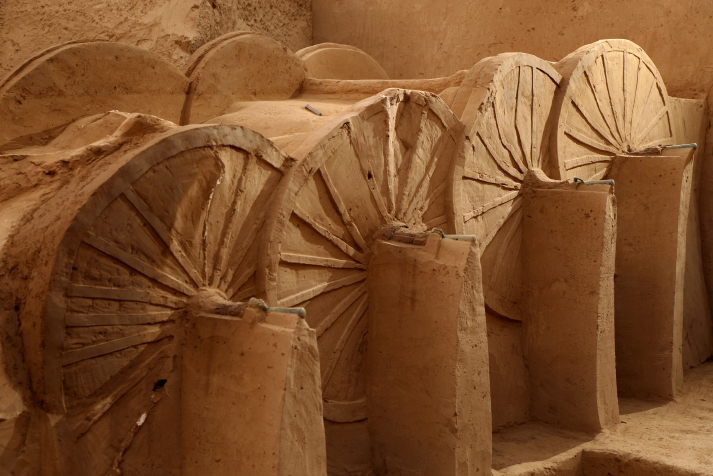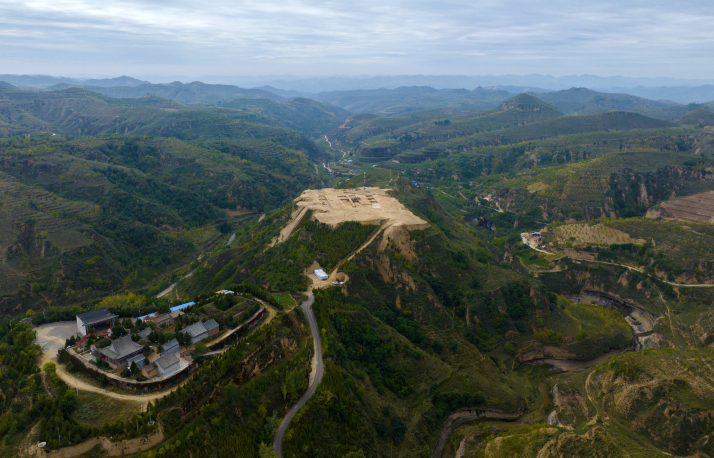| China |
| The remarkable achievements of Shaanxi's archaeologists | |
|
|
 A carriage unearthed in one of the cemeteries at the Zhaigou site (XINHUA)
Shaanxi Province is rich in archaeological heritage. Its capital, Xi'an, was the capital of 13 dynasties up until the end of the Tang Dynasty (618-907), nine of which were stable, united, multiethnic societies that created rich cultures and left behind an abundance of precious relics. On March 22, the Zhaigou archaeological site in Qingjian County was included on a list of China's top 10 archaeological findings for 2023 in recognition of its academic significance, historical and social value, and the innovation used in its exploration, preservation and management. The Zhaigou site contains the remains of a large settlement dating back to 1300-1046 B.C. in the late Shang Dynasty. It includes cemeteries, copper casting sites and residential neighborhoods with a total area of approximately 3 square km. Zhong Jianrong is the head of Shaanxi Academy of Archaeology and Shaanxi Archaeology Museum, and was part of the team applying for the site's inclusion in last year's top 10 list. He told Beijing Review the site's discovery significantly increases archaeologists' understanding of the Shang Dynasty. "In the past, archaeologists studying the late Shang Dynasty mainly focused on Yinxu (the dynasty's capital). As a result, we were not able to evaluate the cultural impact of Shang's core area on its peripheral areas or measure the general size and location of its peripheral tribes," he said. "The Zhaigou site has given us a new opportunity to these buried mysteries." The northern Shaanxi area, where the Zhaigou site is located, was ruled by a regional regime or several regional regimes during that period. Located in Anyang, Henan Province, Yinxu was listed as a World Cultural Heritage Site by the UNESCO in 2006. "The Shang Dynasty is the earliest known dynasty in Chinese history to leave behind a written record, known as oracle bone inscriptions, and is considered the beginning of the Chinese civilization by the international archaeological community," Zhong said. "Exploring the Shang, including its peripheral areas, will contribute greatly to tracking the origins of the Chinese nation." Unveiling the mystery The Zhaigou site features rammed earth structures, large tombs, small burial grounds, pottery kilns and other structural remains scattered across 11 hills. Many bronze chariots and horses, jadeware, bone artifacts, lacquerware and tortoiseshell artifacts were found in the tombs of the nobles at the site. According to the judging panel for the top 10 list, the Zhaigou site was selected as it demonstrates the high level of cultural and economic exchanges that existed between the core area of Shang culture and the northern marginal zone. The site provides valuable information for exploring the political and geographical structure of the Shang Dynasty. The Zhaigou site stands out among all known Shang Dynasty archaeological sites in existence, both in terms of size and the number and variety of the artifacts unearthed there. "In the 1980s, we found ceramic shards in Lijiaya, another site in the periphery of the Shang Dynasty that is sligtly different from that of Yinxu culture, and later on, over 380 similar sites were discovered in the Yellow River area, but these sites are not big enough. In archaeology, the scale of a site largely determines the amount of information we can draw from it," Zhong explained. The Zhaigou site has all the advantages and essential factors. It contains advanced architecture for its time, including 12 T-shaped cemeteries. It is large in scale, with the largest cemetery equaling the size of a king's tomb in Yinxu." The Zhaigou site is also home to the earliest double-barreled carriage as yet discovered in China, pushing the historical record of the vehicle back by 1,000 years. Aside from the record-breaking carriage, many advanced bronzeware items are similar to those found in Yinxu. Golden threaded ornaments discovered there, bearing the characteristics of the northern grassland culture, provided ample evidence for identifying the social position of its owner. "Based on present findings, we believe that the owner of the Zhaigou site was a leader of the peripheral area of the Shang Dynasty, and he maintained close connections with the Shang's central government," Zhong said.  A section of the Zhaigou Shang Dynasty site in Qingjian County, Yulin City of Shaanxi Province (XINHUA)
An interdisciplinary museum Many of the archaeological achievements of Shaanxi are on display at the Shaanxi Archaeology Museum. To better serve both professionals and the public, the museum was carefully designed and divided into sections. It consists of indoor and outdoor exhibition areas. The indoor area not only displays cultural relics and the stories of how they were discovered and unearthed, but also showcases the development process of archaeology in Shaanxi Province, the genealogy of cultural relics, or how relics are related to one another, and the technology of cultural relic protection with text, images and videos. The outdoor area is made up of several themed exhibitions, including brick masonry from previous dynasties, and ceramic and stone cultural relics. In addition to development of museums featuring archaeological relics, China has also been promoting the development of museums at the archaeological sites themselves. These site museums give visitors an immersive experience, allowing them to view relics insitu and to explore the layout of ancient sites. The Shaanxi Archaeology Museum has paid attention to these developments and aims to match site museums in context and immersive experience. "Unlike museums that exhibit only relics, the Shaanxi Archaeology Museum also features the process of archaeological discovery. We want visitors to learn about the theory, tools, basic methods, history and development of archaeology, giving them a more detailed understanding of our ancestors' lives," Zhong explained. "The popularity of archaeology museums is gaining momentum all over the country now, but building an archaeology museum in Shaanxi Province is particularly important because Shaanxi was home to multiple ancient capitals," Zhong continued. "Capitals are usually the most representative cities of a nation's culture." Preservation and popularization aside, another key focus of Shaanxi's archaeologists is to enhance international cooperation. In 2008, Shaanxi Academy of Archaeology partnered with two institutes from the U.S., the Cotsen Institute of Archaeology at the University of California in Los Angeles and the Institute for Field Research, to establish a summer program in China for archaeology students from the United States. The program course gets underway from June to July each year. Specific content includes classroom teaching, business visits and investigations, practical field experience, excavation data organization and interdisciplinary comprehensive research. "Nine archaeology programs were held between 2008 and 2019," Zhong said. "They have promoted academic and cultural exchanges between China and the U.S., and set a great example for fostering understanding between different civilizations. We also intend to deepen communication with archaeology institutes in Central Asian participating countries of the Belt and Road Initiative (a China-proposed initiative to boost connectivity along and beyond the ancient Silk Road routes). We have already begun with Kazakhstan and Kyrgyzstan." (Print Edition Title: Archaeological Marvels) Copyedited by G.P. Wilson Comments to zhangyage@cicgamericas.com _____________ China's Top 10 Archaeological Discoveries in 2023 Ten archaeological discoveries, the earliest of which date back to the Paleolithic age (2.5 million-10,000 years ago), have been included in a list of China's important archaeological discoveries of 2023. The list was announced by China's National Cultural Heritage Administration on March 22 in Beijing. The 10 discoveries are: 1. Bashan Paleolithic site in Yishui County, Shandong Province The Paleolithic site is located at the lower reaches of the Yihe River, which was first discovered in 2020 from a flood discharge downstream. The collected fossils and stone tools evidencing early human life could date back about 50,000 to 100,000 years. 2. Keqiutou Neolithic site complex in Pingtan County, Fujian Province Archaeologists discovered many human bones at the Keqiutou Neolithic site, dating back 7,300 years. The preliminary study shows that the prehistoric human remains of Pingtan County have a close genetic relationship with the ancestors of the Austronesians. The pottery artifacts uncovered from this site are similar to those found at the Dachakeng ruins in Taiwan, showing a correlation to the cultures across the Taiwan Straits. 3. Mopanshan site in Langxi County, Anhui Province Experts said that the relics discovered at the site help scholars to learn more about how prehistoric society became increasingly complex and civilized in the region, and how the Chinese civilization evolved to become pluralistic. 4. The Qujialing Neolithic site in Jingmen, Hubei Province The farmland irrigation and water conservancy structural ruins at the Qujialing Neolithic Site date back 4,200 to 5,900 years. Researchers there believed that the structures were used to combat drought, store water, dispense water for daily use, and irrigate farmlands. 5. Wangzhuang site in Yongcheng, Henan Province The Dawenkou culture is a Neolithic culture that existed from 4300 to 2600 B.C. The site of the Wangzhuang Ruins in Yongcheng City is an important discovery of the Dawenkou culture that has a history originating some 5,000 years ago. 6. Shuyuanjie Cemetery in Zhengzhou, Henan Province The Shuyuanjie Cemetery site dates back to the Shang Dynasty (1600-1046 B.C.). The findings show the site could be the earliest aristocratic cemetery discovered in China and have provided new evidence for the origin of the cemetery and the development of burial standards in China. 7. The Zhaigou site in Qingjian County, Shaanxi Province The Zhaigou site is considered the richest of all known Shang Dynasty archaeological sites in existence, both in terms of size and the number and variety of its artifacts unearthed. 8. The Sijiaoping site in Lixian County, Gansu Province The Sijiaoping site is a magnificent ancestral temple complex used for royal worship and rituals, dating back to the Qin Dynasty (221-206 B.C.). The large-scale ritual building complex was designed with a symmetrical layout. 9. The Chencun ceramic kiln site in Huozhou, Shanxi Province The Chencun ceramic kiln site dates back from the Song (960-1279) to the Qing (1644-1911) dynasties, and was a major kiln group producing refined white porcelain in north China. 10. Northwest continental slope No.1 and No.2 shipwrecks site in the South China Sea The No.1 and No.2 shipwrecks near the northwest continental slope of the South China Sea are both relatively well-preserved and a large number of relics identified as Ming Dynasty (1368-1644) artifacts were unearthed at the two sites. (Source: China Global Television Network) |
|
||||||||||||||||||||||||||||
|